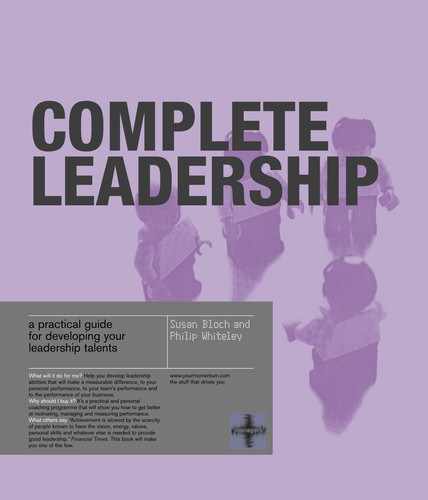
momentum complete leadership chapter four
75
pages 74 /
chapter four
the picture comes back
from the developers –
how the team sees you
momentum complete leadership chapter four
75
pages 74 /

We all have our favourite photos of ourselves, where we fancy there
is at least a passing resemblance to George Clooney or Julia Roberts.
We also have our least favourite, where the hair sticks out, our
mouth is set in a grimace, and the lines on our face look like a map of
the Rockies.
Yet we probably didn’t feel any different when the best and the
worst pictures of ourselves were being taken. Behaviour is a little
like this. We can have very little awareness of how we come across to
others. Our scorecard from the previous chapter may have revealed
that when we thought we were being authoritative, really we were
being coercive; when we thought we were being democratic, we
were being pace-setting. We thought we had communicated well, but
actually we expressed irritation at having to tell the team what the
plan was, with the result that they felt fearful and did not listen.
Learning points from this chapter
◆ How your team perceives you is important; it may be
different from how you think you put yourself across.
◆ A low score on a key attribute or on self-awareness is not
evidence of a character flaw; it is best not to react
defensively.
◆ Complete leadership doesn’t involve choosing between
being directive or democratic but being able to deploy either
style, depending on the situation.
As we await the results of the initial feedback, we are in a sense
waiting for the picture to come back from the developers. The
metaphor may be dated – we live in a digital age without needing to
develop photographs on film – but there is always at least a pause
before we see how we look in a snap that has just been taken. We can
be anxious in that pause.
If you have completed the questionnaires, or you’re gathering
information from 360-degree or other means, you’re waiting for the
photograph to come back from the developers. So, how will it be?
It will offer valuable information on your strengths, and your
awareness of them compared with your team’s perceptions of you.
But you may receive some unpleasant surprises. This is to be
expected. A low score doesn’t indicate a character flaw. If you are not
brilliant at everything, that’s fine. The key is to think of the things
that you can do differently that would make a difference. In Chapter
5, we will set out a ‘3-D development programme’ summarizing
your key tasks.
Greg Lewin, president Shell Global Solutions, reports how an
incident with a direct report encouraged him to consider how he
came across to others:
‘With one colleague, his line of the business was being reviewed
in a meeting. It is in the nature of these fish-bowl processes
(that we have at Shell) that they are high challenge and high
support. I looked at the numbers and we looked at cost
performance, and the numbers were unacceptable to me. I said
“I don’t accept your costs,” and I meant it as being just that, but
he took it as my saying “I don’t trust you and I doubt your
information.” It took a long time for us to reconnect after that. To
me it was just an observation. I had misjudged the position that
the individual was coming from . . . I could have been much
more coaching than challenging.’
This is an example of someone feeling they were being informative,
when the direct report felt he was being coerced. What matters here
momentum complete leadership chapter four
77
pages 76 /
..................Content has been hidden....................
You can't read the all page of ebook, please click here login for view all page.
